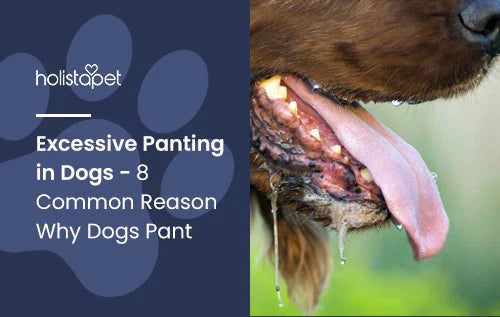Has your furry friend been limping or acting unusually stiff? They might have strained a muscle! A pulled muscle in dogs is pretty common, especially in active canines.
Let's see how to spot a pulled muscle in your dog's body. This read will help you understand the common causes and give helpful tips for a smooth recovery. Join along and learn how to keep your canine companion happy, healthy, and pain-free!
What Is a Pulled Muscle?

A pulled muscle, also called a muscle strain, happens when muscle fibers tear. This soft tissue injury occurs from overstretching or overexerting the muscle. It can happen from sudden movements, like jumping off furniture or intense play.
A muscle pull can range from a minor discomfort to a severe muscle tear. The severity of the muscle injury will determine the recovery time. Pet owners must understand what a dog's pulled muscle is to know how to best help their furry besties.
Common Causes of Pulled Muscles in Dogs
Like us dog owners, our canine friends can pull a muscle from various activities. Here are some common causes of dog muscle strain:
- Sudden Bursts of Activity. Quick, powerful movements can sometimes overstretch or tear muscles.
- Lack of Warm-Up. Jumping straight into intense exercise without warming up is a common cause.
- Overexertion. Too much exercise can cause muscle fatigue and injury, especially for working dogs or dogs participating in canine sports.
- Traumatic Injuries. Accidents, like falls or collisions, can cause direct trauma to the muscles.
- Obesity. Obese dogs are more prone to muscle injuries, as the extra weight puts additional stress on their muscles and joints.
Which Dogs Are Most at Risk for Pulled Muscles?
Any dog can experience a muscle strain, yes. But some canines, like the following, are more prone to these injuries due to their size, activity levels, or genetic risk factors:
- Large Breed Dogs. These dogs often have deeper chests and longer limbs, which can increase their risk of muscle pulls.
- Working Dogs. Dogs involved in demanding activities like herding, agility, or competitive sports are more likely to experience muscle strains.
- Obese Dogs. Excess weight puts extra strain on joints and muscles, increasing the risk of injury.
- Older Dogs. As dogs age, their muscles can become weaker and less flexible.
- Dogs with Certain Breed-Specific Conditions. Some breeds, such as Labrador Retrievers, may have a higher predisposition to certain muscle disorders that can increase their risk of injury.
How To Tell if a Dog Pulled a Leg Muscle
Keep an eye out for some telltale signs that your furry friend might have a muscle strain. For example, they might not be able to put full weight on the injured leg, or they might limp or favor one side. You might also notice them being less active than usual or showing signs of discomfort.
Signs and Symptoms of a Pulled Muscle
Spotting a pulled muscle early can help your pup get the care they need quickly. Here are some common signs and symptoms to watch for:
- Limping or Favoring a Limb. Your dog might hold up the injured leg or put less weight on it.
- Reduced Activity Level. Your pup might seem tired, sluggish, and reluctant to run, jump, or play.
- Swelling or Tenderness. The injured area might be swollen or warm and tender when touched.
- Stiffness. Your dog may be stiff, especially after resting.
- Changes in Behavior. Your dog might whine, pant, or show other signs of discomfort and become irritable or withdrawn.
Differentiating a Pulled Muscle From Other Injuries
Pet owners need to know what is and is not a muscle injury. Basically, a pulled muscle affects just the muscle tissue itself.
On the other hand, a ligament injury, like a torn cranial cruciate ligament, involves the connective tissue that connects bones. Ligament injuries often cause more severe instability and discomfort.
Another possible injury is a bone fracture. This usually causes extreme discomfort and an inability to bear weight. If you're unsure, a visit to the vet is best.
Related Post: Elbow Dysplasia in Dogs Explained + Best Care Tips
How to Care for a Dog With a Pulled Muscle
The winning combo here is rest, discomfort control, and a comfortable environment. This approach helps promote healing and prevent further injury. Let's look at specific steps and tips to help your furry friend recover quickly and comfortably.
Immediate Steps To Help Your Dog
If you suspect your dog has a muscle pull, take immediate action. Here are some initial steps you can take:
- Restrict Activity. This may involve strict crate rest or keeping them on a leash for potty breaks only.
- Apply a Cold Compress. Use a cold compress on the injured area for 15-20 minutes several times a day to help decrease swelling.
- Consult Your Veterinarian. See your vet to get a proper diagnosis and discuss treatment options.
Rest and Recovery Tips
Rest is crucial for a smooth healing process. Here's what you can do to help your pup recover:
- Strict Crate Rest. Limit your dog's movement to a small, confined space like a crate or sectioned-off area. This is especially important for severe strains to avoid further injury.
- Controlled Exercise. Once the initial discomfort decreases, your vet may recommend controlled exercise to gradually rebuild strength.
- Muscle Support Supplements. Options like our Muscle Support Soft Chews for Dogs may support your dog's muscle recovery. Our chews feature a natural blend of amino acids and muscle-building ingredients to aid your pup's recovery plan.
- Promote Rest. Sleep is essential for healing. Our Melatonin for Dogs, with a blend of calming ingredients like L-theanine, chamomile, and valerian root, can help your pup relax and catch some Zs.
Creating a Comfortable Environment
A comfortable environment can significantly boost your dog's recovery. A stress-free environment is key for a speedy recovery.
Make sure your furry buddy has a soft, supportive bed in a quiet area where they can rest undisturbed. This helps minimize pressure on the injured muscle and promotes relaxation. Also, keep their food and water bowls nearby so they don't have to move around too much.
Related Post: Should You Walk a Dog with Luxating Patella? [Risks vs Rewards]
How to Comfort a Dog That Has a Pulled Muscle
Seeing your dog struggle from a pulled muscle can be tough, but you can support and comfort them in many ways. This involves more than just physical care; it's about providing emotional support and creating a calming atmosphere. Let's look at some techniques to help you soothe your furry friend.
Using Warm or Cold Compresses
Cold and warm compresses can be helpful tools in managing your pet's discomfort from a muscle strain. Use a cold compress in the first 24-48 hours after the injury to decrease swelling. Apply a cold pack wrapped in a towel for 15-20 minutes at a time, several times a day.
After the initial swelling has subsided, use a warm compress to increase blood flow to the area and encourage healing. Again, use a warm (not hot) compress wrapped in a towel for 15-20 minutes at a time.
Ease Discomfort With Cannabidiol (CBD)
Cannabidiol, or CBD, is a natural compound found in hemp plants. It interacts with the body's endocannabinoid system (ECS), which helps regulate various functions, including discomfort perception.
CBD wellness products may offer therapeutic benefits for dogs with pulled muscles by promoting relaxation and easing irritation. Consider HolistaPet's CBD Crunchy Treats, CBD Soft Chews, CBD Oils, and CBD Capsules for Dogs. These products offer different ways to give your dog CBD and may help support their overall well-being and comfort during recovery.
Gentle Techniques To Soothe Your Dog
Besides compresses and CBD, gentle techniques can provide additional comfort to your dog. These methods focus on providing physical and emotional support:
- Gentle Massage. Lightly massaging the surrounding muscle tissues (not the affected area itself) can help improve blood flow and reduce muscle tension. Be very gentle and stop if your dog shows any signs of discomfort.
- Quiet Time and Affection. It is important to provide a calm and quiet space for your dog to rest. Offer gentle petting and reassurance to help them feel safe and secure.
- Speak in a Soft Voice. Use a calm and soothing tone of voice when interacting with your dog. This can help reduce anxious behaviors and promote relaxation.
What Will a Vet Do for a Pulled Muscle?
Veterinarians are the best experts in treating pulled muscles in dogs. Here are some common things your vet might do:
- Diagnostic Tests for Pulled Muscles. Your vet will likely perform a physical exam, checking your dog's limbs and surrounding muscle tissues for signs of swelling, tenderness, or reduced mobility. They may also recommend X-rays to rule out other injuries.
- Treatment Options Your Vet May Recommend. Depending on the severity of the muscle strain, your vet may recommend several treatment options, including crate rest, pain control with nonsteroidal anti-inflammatory drugs (NSAIDs), passive physical therapy, and, in some cases, sports medicine.
How Long Does a Pulled Muscle Take to Heal in a Dog?

The healing time for a dog muscle strain varies depending on several factors, mainly the severity of the injury. With rest and proper care, a mild muscle strain might heal in a few weeks. More severe muscle tears or strains can take longer, sometimes several weeks or even months.
Recovery Time Based on the Severity of the Injury
The severity of the muscle pull directly impacts the recovery timeline. Moderate strains, where some muscle fibers get torn, may require several weeks of rest and limited activity.
More serious strains involving a significant muscle tissue tear can take much longer to heal. Think months of strict rest, controlled exercise, and potentially other therapies like physical therapy.
Factors That Influence Healing Time
Several factors can influence how quickly a pulled muscle heals in a dog. These include:
- Severity of the Injury. As mentioned earlier, more severe injuries will naturally take longer to heal.
- Dog's Age and Overall Health. Younger, healthier dogs tend to heal faster than older dogs or those with underlying health issues.
- Adherence to Treatment Plan. Not following your vet's instructions, such as allowing your dog to run and jump too soon, could cause further issues and delay recovery.
- Presence of Scar Tissue or Other Complications. In some cases, scar tissue may form during the healing stage, limiting flexibility and range of motion. Other complications, such as infection or further strain on surrounding tissues, can also extend healing time.
How To Prevent Pulled Muscles in Dogs
Preventing a pulled muscle in your dog is all about promoting healthy habits and taking precautions. Here are some key prevention strategies:
- Practice Warm-Ups Before Activity. Dogs benefit from warm-up exercises before engaging in strenuous activity. A few minutes of light walking or stretching should do the trick.
- Provide Muscle Supplements. Appropriate wellness products can support your dog's muscle health. For example, HolistaPet's Muscle Support Soft Chews for Dogs provides a natural blend of amino acids and muscle-building ingredients that may help strengthen muscles. These tasty treats are a great way to supplement your dog's diet.
- Maintaining a Healthy Weight for Your Dog. Keeping your dog at a healthy weight is key. Excess weight puts extra stress on their muscles and joints, making them more prone to injury.
- Low-Impact Exercises To Strengthen Muscles. Regular, low-impact exercises like swimming or leash walks can help strengthen your dog's muscles.
When To Seek Veterinary Help
While many pulled muscles can heal with rest and home care, it's important to know when to seek professional veterinary help. If your dog's pain is severe, worsens, doesn't improve within a few days, or if you notice any other concerning clinical signs, a vet visit is an absolute must.
Recognizing When a Pulled Muscle Is Serious
Knowing when a pulled muscle requires veterinary attention is essential for preventing complications. Here are some signs to keep in mind:
- Severe Discomfort. If your dog is showing significant signs of discomfort, such as constant whining, excessive panting, or reluctance to move at all, seek veterinary help.
- Inability to Bear Weight. If your dog cannot put any weight on the injured limb, this could indicate a more serious injury.
- Swelling That Doesn't Improve. If the swelling in the affected area doesn't decrease within a few days, or if it worsens, consult your vet.
- Behavioral Changes. If your dog becomes lethargic, loses their appetite, or exhibits other unusual behaviors, it could point to a more serious problem.
- Symptoms Persist. If your dog's symptoms do not improve within a few days of rest and home care, have your dog examined by a veterinarian.







![Probiotics For Dogs [Soft Chews] - HolistaPet](http://www.holistapet.com/cdn/shop/files/Probiotic-Infographic-1_472d7a29-e30c-435a-9638-1365d8c3a9f9.jpg?v=1725384841&width=104)



























Leave a comment
All comments are moderated before being published.
This site is protected by hCaptcha and the hCaptcha Privacy Policy and Terms of Service apply.